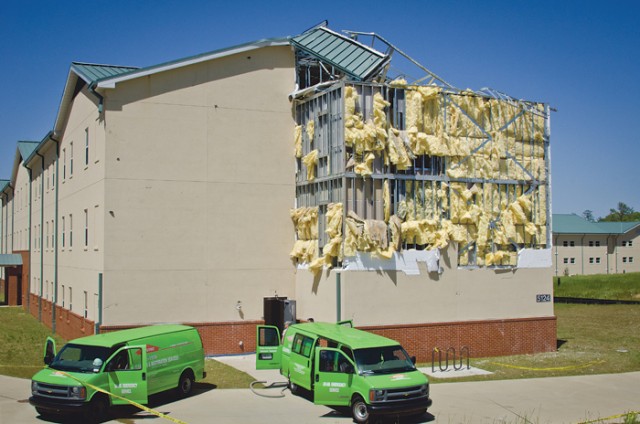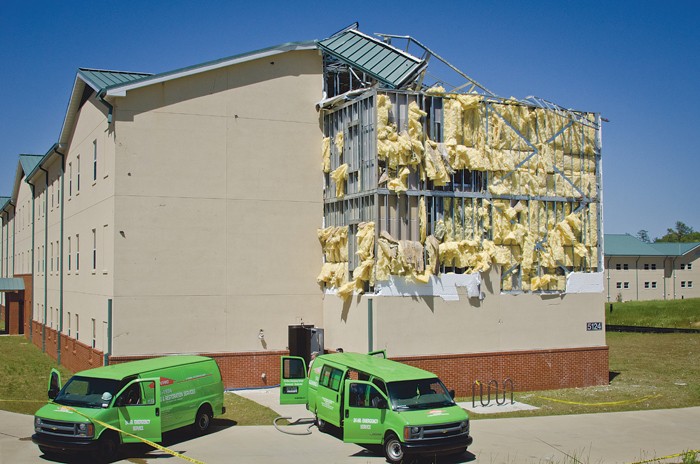
FORT BENNING, Ga. - Fort Benning officials believe the lack of injuries during the severe weather April 15-16 is a direct result of the effective use of composite risk management.
Winds speeds reached 100 mph when a small tornado touched down during the Best Ranger Competition, but there were no injuries and no close calls among the many Ranger teams, Soldiers and personnel scattered across Harmony Church.
That's no coincidence, said Kestner Edens, mission safety manager for the installation Safety Office.
"If it wasn't for the leadership and their thought process, it could have been worse," he said. "Composite Risk Management is the Army's decision-making process for identifying hazards and controlling risk across the Army's full spectrum of missions, operation, functions and activities. You identify the hazard. You develop the controls. You make your risk decision. Then you're going to implement your control measure."
Since the 4th Ranger Training Battalion regularly conducts high-risk training and events, unit personnel are familiar with the precepts of composite risk management, Edens said.
"They have standard operating procedures in place to help conduct a safe stand down," said Edens, who oversees training and provides commanders feedback on the best way to mitigate any hazards. "If lightning is striking within a certain proximity, they go into a lighting lock down. They wait for the storm to pass before they move on to continue their operations. The tornado and the severe weather is no different."
Weeks in advance of the competition, unit leaders planned specific procedures to follow for all anticipated risks, including the potential of inclement weather, said Lt. Col. Jeremy Miller, commander of the 4th RTB.
The safety procedures were then rehearsed at company, battalion and brigade levels, Miller said.
"Weather conditions were closely monitored every 12 hours beginning five days prior to the execution of the competition," Miller said. "Weather monitoring continued hourly throughout the first day of the competition."
As forecasts predicted the weather and wind speeds would worsen, Miller postponed the start of the orienteering event, originally scheduled for 7 p.m. April 15. After reports of damage from hail and wind, competitors moved to a secure lightning holding area, where they waited until the storm moved north and it was safe to begin the event.
Once the event started, safety was kept at the forefront, Miller said.
All 68 competitors were tracked using the Deployable System for Training and Readiness. They each carried an emergency response kit with a military GPS, set of batteries, a chemlight, whistle, an MRK radio with preset emergency station and one red star cluster. They were also briefed on how to react in emergency weather situations.
Company and battalion chain of command kept in steady contact with Lawson Army Airfield and were apprised of the severe weather cell, which eventually developed into a tornado, headed for the area, Miller said.
"Based on these weather conditions and visible atmospherics in the training area, the decision was made to end the course at Checkpoint 3 and begin consolidating competitors using their DSTAR," he said.
Checkpoints went into lightning lockdown procedures while competitors were collected and transported back to Camp Rogers, where they were placed in the student barracks to wait out the lightning and tornado.
"Several actions led to the successful and safe execution of this event under these extreme conditions," Miller said. "Most important was the planning and analysis at all levels to prepare for and mitigate risks. The forward positioning of leaders on the ground, leader experience, a functional communication architecture and multiple layers of contingency plans created the conditions for accurate and rapid information flow throughout these extraordinary circumstances. In the end, the safety of the competitors and support personnel was the primary influence for all decisions."
The EF-1 tornado, which touched down at 4:50 a.m. April 16, traveled northeast in a 50-yard-wide path for a quarter of a mile. It damaged Armor School buildings 5124, 5122 and 5140, Building 4157 and fencing at the Warrior Training Center, several cars and power lines along 8th Division Road.
The total damage is estimated between $5 and $6 million, said Kirk Ticknor, chief of operations and maintenance for the Directorate of Public Works.

Social Sharing